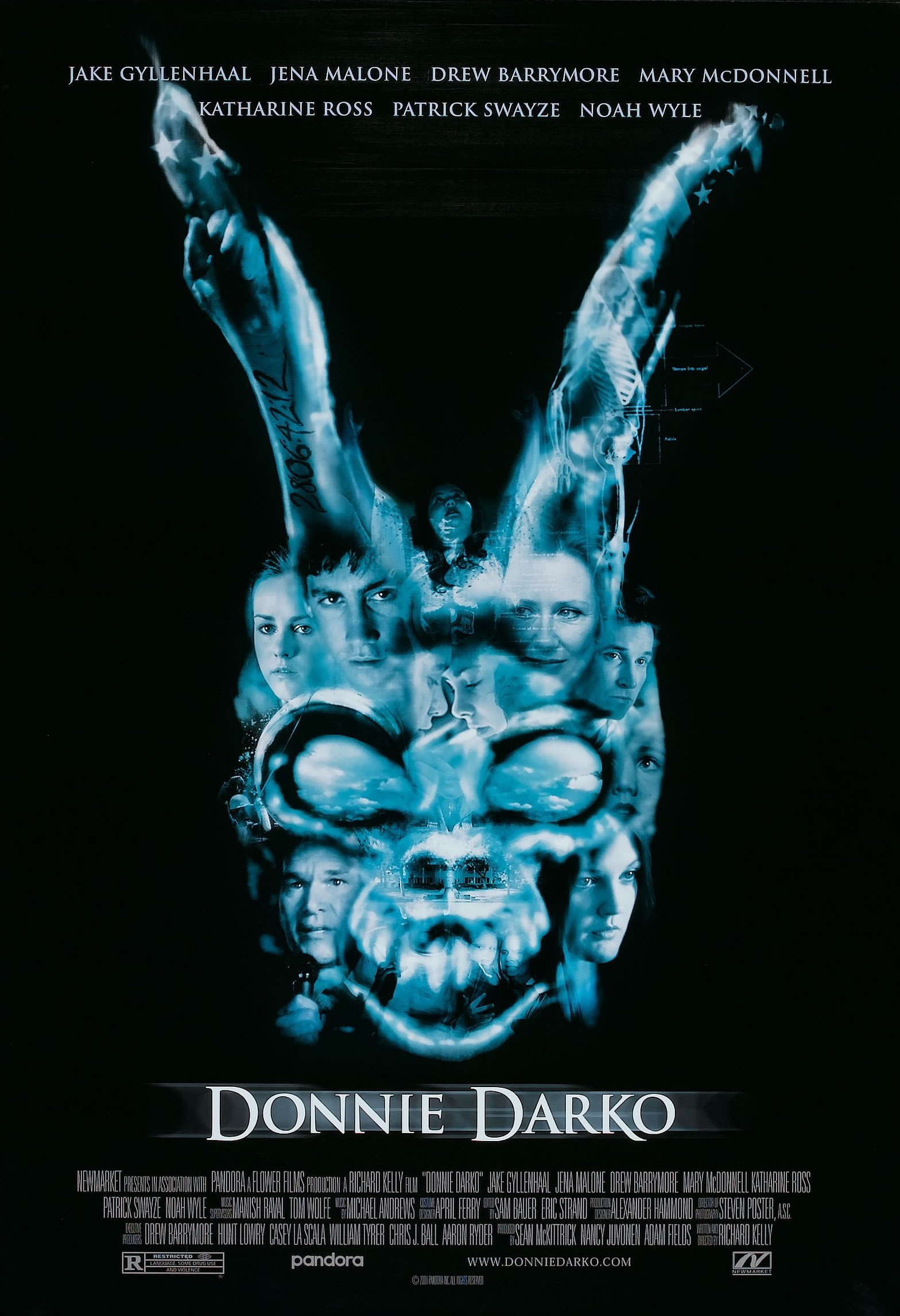SYNOPSIS
Donnie Darko begins on October 2 with the appearance of Frank, a sinister giant rabbit who saves Donnie from being killed by a mysterious jet engine falling from the sky. Frank informs the title character of the world’s imminent demise and Donnie unwillingly and unknowingly is transformed into the protagonist of a quest to save the universe. As the story progresses, Frank’s appearances become more and more troublesome, as evidenced by Donnie’s increasingly bizarre behavior and his disclosures to his psychiatrist while under hypnosis who believes him to be delusional. Donnie subsequently receives a diagnosis of paranoid schizophrenia.
At Frank’s command, Donnie asks his science teacher about time travel, and is given The Philosophy of Time Travel, a guide written by a former science teacher at his school who is now an urban legend. The book describes a scenario whereby a tangent universe (TU) may arise due to disruptions in time. The TU is inherently unstable, and its collapse marks the end of both universes unless a specific metal artifact (e.g. plane engine) is returned to the primary universe (PU) through a vortex. As the film progresses, the concepts of time travel and alternate universes become entwined with Donnie’s frank portrayal of psychopathology, forcing a tension between the storyline as straight science fiction versus a direct depiction of severe mental illness.
THE PSYCHIATRY OF DONNIE DARKO
Discordant interpretations of Donnie Darko are possible depending if the viewer accepts or rejects the premise of time travel as a plot device.
Rejecting the time travel hypothesis
With the concept of time travel reduced to a paranoid and grandiose delusion, Donnie Darko is a case study of a first-break psychotic episode. In the “Schizophrenia Spectrum and Other Psychotic Disorders” section of the DSM-5, a diagnosis of schizophrenia is made when patients demonstrate social or occupational dysfunction for at least 6 months with at least 1 month of symptoms (delusions, hallucinations or disorganized speech + either disorganized behavior or negative symptoms). Donnie’s presentation includes the hallucination of Frank and the delusion that the world will end in 28 days, 06 hours, 42 minutes, and 12 seconds. In addition, his behavior is bizarre and he has profound “negative symptoms:” blunted emotionality, decline in speech (alogia) and reduced motivation (anhedonia). While psychotherapy focuses on improving social and occupational functioning, the mainstay of treatment is with pharmacotherapy. While dopaminergic drugs are effective in controlling the hallucinations, delusions and bizarre behavior, the negative symptoms may be refractory to treatment. While the majority of persons with schizophrenia are nonviolent, command and persecutory delusions may make sufferers particularly unpredictable. High prevalence of cormorbid substance abuse disorders, homelessness, and incarceration are complicating factors impacting treatment efficacy and compliance. While there is some evidence suggesting that childhood sexual abuse may increase the likelihood of schizophrenia, this point is contested. In the director’s cut of Donnie Darko, there is a portrayal of a sexual encounter with his psychiatrist during hypnotism, possibly suggesting this association (or perhaps underscoring the vulnerability of this population).
Furthermore, if the onset of his delusions and hallucinations is subsequent to Donnie’s near- death experience with the falling jet engine, then Trauma and Stressor Related Disorders would be worth diagnostic consideration as well.
Accepting the time travel premise
If one accepts the time travel tale as possible, Donnie emerges as the tortured hero in the spirit of Joseph Campbell. According to Campbell’s theory, the hero must be cast out of his normal reality (here, called by Frank and jolted into the alternate universe by the falling jet engine) onto a path of self-exploration, personal growth and ultimate acceptance and command over his fate. Though Donnie’s obedience to Frank’s commands signifies a willingness to accept his destiny, his first open declaration to this end comes with his investigation into time travel. The Philosophy of Time Travel declares that inhabitants of the alternate universe (TU) exist in the service of Donnie’s success at repairing the rift in space-time. Perhaps in an effort not to interfere with his quest, Donnie’s psychiatrist prescribes him placebos for his apparent schizophrenia. He perseveres, guided by Roberta Sparrow, who helps him overcome his fear of death. Donnie’s hero’s journey ends with his discovery of telekinetic power and ultimately his acceptance that his death is necessary.
It is academically curious that The Evil Dead (1981) is featured in Donnie Darko. Its parody sequel, Evil Dead 2: Dead by Dawn (1987), serves as a teaching tool for the Dissociative Disorders (DD). Arguably, one of the most iconic scenes in cult film history features Ash versus his own (alien) hand. Through a psychiatrist’s lens, the scene depicts Depersonalization/Derealization Disorder; a type of DD where the individual experiences unreality with respect to his body or actions. By featuring The Evil Dead in Donnie Darko, a link is then established between the psychotic and dissociative disorders.
Current debate about the etiology of the Dissociative Disorders concerns the role of early life trauma and defining a distinction between disassociation as a defense mechanism versus a psychopathology. It has been proposed that the neurobiological mechanisms underlying Schizophrenia and Dissociative Disorders may be common, forming some of the recent debate regarding where the Dissociative Disorders should be included in future versions of the DSM. Additional psychotic-dissociative links between the 2 movies are detailed in Table 1 below.
| Table 1. Links between The Evil Dead and Donnie Darko | |
|---|---|
| Evil Dead 2: Dead by Dawn | Donnie Darko |
| Sam Rami's original film, The Evil Dead, is shown in Donnie Darko | |
| Follows The Philosophy of Time Travel featuring Ash as the hero archetype | Follows The Philosophy of Time Travel featuring Donnie as the hero archetype |
| Roberta (Bobby) Joe, Jake's girlfriend | Roberta Sparrow (Grandma Death) |
| Henrietta Knowby is trapped under a cellar door | Karen Pomeroy teaches that "cellar door" is the most linguistically perfect word in the English language |
| Both movies end in vortices | |
